
Trajan Vuia, (1872-1950)
Trajan Vuia was born on August 17, 1872 in a village known as Surducul Mic in the Timis county of Romania. It was a small village in the western part of Romania, in the vicinity of the present border between Romania and Hungary. Today this village bears the inventor's name: Trajan Vuia.
After one year, because of financial problems, he joined the Faculty of Law in Budapest. The main reason was the possibility to work and make some money (as a student at the Polytechnical University of Budapest he could not do that). Despite this change which came out in his life, he continued to study by himself those technical problems which he was particularly interested in, the most important one being the problem of flight.
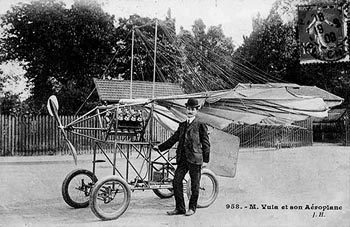 Trajan Vuia, 1906/7 Download a 750pixel image
In may 1901 he was awarded the Ph.D. degree in Law by the Faculty of Law in Budapest. After graduation he returned to Lugoj. Here he accomplished his studies about human flight and designed his first flying machine which he called "the airplane-car". He tried to build this machine in Lugoj, but, because he had no material help, decided to go to Paris. On the first of July 1902 he arrived in Paris. Vuia was hoping that in Paris - considered at that time the center of the aeronautical world - he would find somebody interested in his project. In Paris, Vuia began to look for help among those interested in aerial navigation using ballons. But these persons did not believe that a flying machine which had a density greater than that of the air could fly, since their flight principles were based on Archimede's law. In these circumstances Vuia addressed Prof. Tatin, known as a very good theoretician and experimentator as well. In 1879 Tatin had succeeded in building an aero-model. Tatin was interested in Vuia's project, but also tried to persuade him that he would do nothing, because its flying machine did not have a suitable engine (which was expected by all constructors of flying machines at that time). Tatin's main argument against Vuia's engine project, was that it had only one propeller, while all aero-models which had flown had had two parallel propellers rotating in opposite directions (from stability considerations). However Vuia continued to sustain his project and submitted it to the Science Academy of Paris on February 16, 1903. In this project he demonstrated the possibility of mechanical flight with a machine that had a density greater than that of the air. He also presented his procedure for taking off. This project was entitled 'Project of an airplane-car'. The special Commission of Aeronautics of the Science Academy of Paris, considered Vuia's project an utopia. They rejected it, adding the comments: 'The problem of flight with a machine which weights more than air can not be solved and it is a only a dream.'
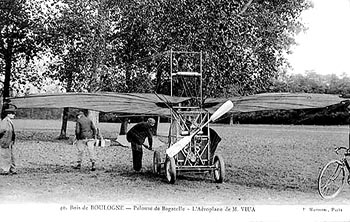 Trajan Vuia's monoplane in the Bois de Boulogne, 1906/7 Download a 750pixel image
Vuia did not give up and applied for a license for its machine from the Office of Industrial Property in France. On August 17 , 1903 he received this licence. It was officially published on October 16, 1903. Decided to give life to his invention, Vuia had begun to build the flying machine during the winter of 1902-1903. Despite of a lot of difficulties, the most important being of course the financial ones, he succeeded in his attempt. During the autumn of 1904, he began to build the appropriate engine, also an invention of his own. During the same year (1904) Vuia got a license for his invention from Great Britain. This flying machine was called by his constructor 'Trajan Vuia 1'. It was a single-plane airplane with a high-wing. The second difficult problem solved by Vuia was to build an engine which could develop a propulsion force to assure the autonomous taking off. The first airplane engine appeared in 1903, built by Wright brothers. The second one, built by Charles Manly was used by Prof. Langley for his airplane; he tried to fly with it two times in 1903 but he failed. ( * This engine can be seen in Washington, at 'National Air & Space Museum' * ). The third engine was Vuia's. It was the second engine in the world which worked on a flying machine.(*Vuia's engine can be seen in Paris, at 'Air Museum'; a copy of it is in Bucharest, at 'Central Military Museum'*).
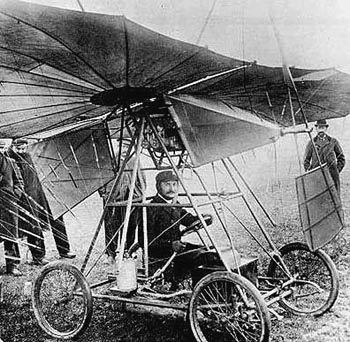 Trajan Vuia's monoplane (detail), 1906/7
The propeller of Vuia's flying machine was built by Tatin, who, seeing that Vuia's airplane becomes a reality, decided to help him. The propeller was the only part of the airplane built by Tatin. The main characteristics of Vuia's first airplane were:
span : 8.70 m;While he was building his airplane Vuia received some visitors like George Besancon, Santos-Dumont etc., well known as personalities in aviation. Most of them were shocked by the fact that Vuia adopted a mono-plane solution for his airplane, because all planors which had flown by then were built after Lilienthal-Chanute double-plane idea. Vuia's argument was that he was inspired by nature (he used to say 'I have never seen a bird with more than two wings'). They were also worried because Vuia's machine had only one propeller so airplane 's stability was difficult to maintain. 'Vuia 1' airplane was completely built in December 1905. Now Vuia had to chose a suitable place to test his machine; he found a plain called Montesson, near Paris, where he could not be disturbed by spectators. His first experiences began in December 1905. In this period he used his machine only as a car; the wings were not mounted on it. After he became a very good pilot for his 'car' Vuia changed it into what he called 'airplane-car' by adding the wings. In this configuration the machine was still used as a car only, till it could attain safely a speed of 40 km/hour without using the engine at its maximum capacity.
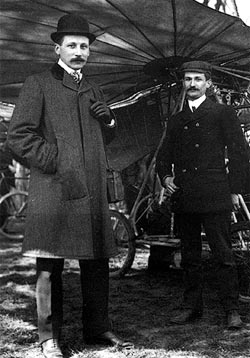 Leon Delagrange, (l) with Trajan Vuia, 1906 Download a 500pixel image
By now nobody, except one of the men who had helped him building the machine, attended these experiences. In February, after they heard of Vuia's successes, more people - including George Besancon and others -joined him to see the attempts. During February many papers in France began to devote large spaces to Vuia's machine. Considering the weather warm enough, Vuia decided to make his first flying attempt on March 18, 1906 . He had established to make the attempt in the afternoon, so at three o'clock p.m. he set out the engine. After five minutes his machine began to move. After an accelerated motion (about 50 meters long) 'Vuia 1' left the soil and flew at a height of about 1 m. After about 12 m in flight, some problems occurred at the engine so the propeller stopped and 'Vuia 1' landed. Vuia was very happy he could fly with his machine. At that time that flight constituted a notable performance. It was the first flight with a machine which weighted more than the air and was entirely driven only by its on board installations during all its evolution (unlike Wright's brothers machines). Of course such an event was exploited by the mass-media; a lot of papers in France, USA, Great Britain, etc. noted that at Montesson an autonomous flight had taken place. Six moths later Santos-Dumont succeeded in a similar attempt; he is sometimes quoted as the first who flew using only his on board installations, because his flight was officially controlled. But Vuia had flown many times before: March 18, June 24 at Issy-les-Moulineaux (also in France), July 1, July 5, July 14, August 12, August 19, etc.
 Trajan Vuia's flight announced in the New York Herald, 1906
In 1907 Vuia flew many times. A notable event took place on March 27 when Vuia, Santos-Dumont and Bleriot attended an aviation meeting at Bagatelle. Only Vuia succeded in his attempt, while Santos-Dumont and Bleriot could not even take off. Santos Dumont made only three flights during this period: the first on September 13, 1906, then October 23, November 12, 1906 when the first flight was officially controlled. After these Santos-Dumont gave-up his first airplane and built a new one, completely different. In 1907 the number of autonomous flying machines increased rapidly; Charles Voisin on March 16 and 30, Louis Bleriot on July 11, 25 etc., Henri Farman on September 30, Esnault-Pelterie in October etc. The first aerial trip was made by Henri Farman on October 30, 1908, from Bouy to Reims. The first aerial raid (Toury-Artenay-Toury) by Bleriot on October 31, 1908. During 1908 Wilbur Wright, came in France and established a lot of records with his machine. Notice that all these pioneers flew double-plane airplanes. Only Bleriot, after some unsuccessful attempts, reached the idea of Vuia (the single-plane) in 1907. After 'Vuia 1', Trajan Vuia built 'Vuia 1 bis' which was equipped with the same engine but was enhanced by his constructor, and 'Vuia 2' which was equipped with a new engine built by the French engineer Leon Levavasseur. Vuia also built two helicopters in 1918 and 1922.
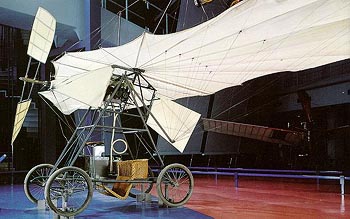 Trajan Vuia's monoplane today
Some historians of aviation pretended that Vuia was inspired by the airplane built by Clement Ader, which attempted to fly in 1897. But there are big differences between the two machines. Clement's machine's wings were very different from Vuia's design and these probably caused his failure. Clement pretended that he flew in 1897, but historians of aviation demonstrated he could not fly exactly because of these wings. In 1907 - after so many successful autonomous flights - Vuia considered that the problem of mechanical flight was completely solved. He later declared: 'the creation of airplane was completely finished in 1906. After that the constructors industrialized the aviation, of course a very important mission but it can not be confounded with the creation of the new machine. On the other hand it is clear that the airplane was created in France, despite of the fact that it is usually claimed that Wright brothers created the aviation. Even when they came in France, in 1908, they used the same procedure for taking off, which implied a non-autonomous flight. Wright brothers adopted the new style of taking off later. This should be repeated because many forgot it' (T. Vuia's book 'Memories', 1955). Main reference: Gheorghiu, Constantin C., Romanian inventions and prioritites in aviation, Ed. Albatros, Bucharest, 1979 (in Romanian) This article was posted in the Romanian mailing list romanians@sep.stanford.edu by Cornel I. Sultan.
Trajan Vuia, France March 18, 1906 : Despite the credit generally given Santos Dumont, it would appear that Vuia was the first beside the Wrights to take off with a powered airplane. After some days of trials at Sartrouville, beginning March 2, a flight of about 12m. was made on March 18. The machine was a miniature tractor monoplane, wings arched laterally, rudder immediately to rear of chassis, 25 h.p. carbonic-acid gas engine. No appreciable flights were made, however, until August 12. After changes in the machine (Viua II), and a rear horizontal stabilizer added, a flight of 8-10m. was made at Montagny, June 21. Other flights were as follows: July 19, 1906 : 20m., Montagny; August 19, 1906 : 24m., Montagny; October 7-14, 1906 : 4m., Issy; January 26, 1907 : ?m., Bagatelle; March 2, 1907 : 4-10m., Bagatelle; March 9-27, 1907 : Running on ground and up to 3-4m. April 1907 Machine modified and Antonoinette 24 h.p. engine installed. This was a tractor monoplane with folding wings of steel tube ribs, rudder aft hinged to chassis, fixed horizontal stabilizer aft on outrigger and an elevator further aft. Jul 5, 1907 : Flew 20m. and crashed at Bagatelle.
Vuia never attained further prominence in aeronautics, and made no further flights.
 Vuia's Aeroplane, La Nature, c.1906 Download hi res copies of each page [ 164 ] [ 165 ] [ 166 ] approx 400kb each
|
© Copyright 1999-2002 CTIE - All Rights Reserved - Caution |


